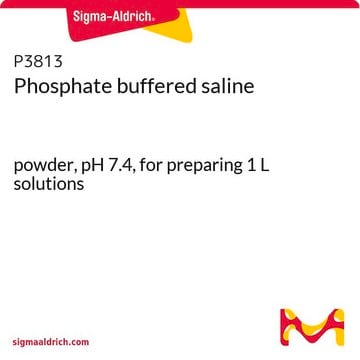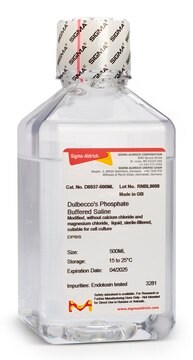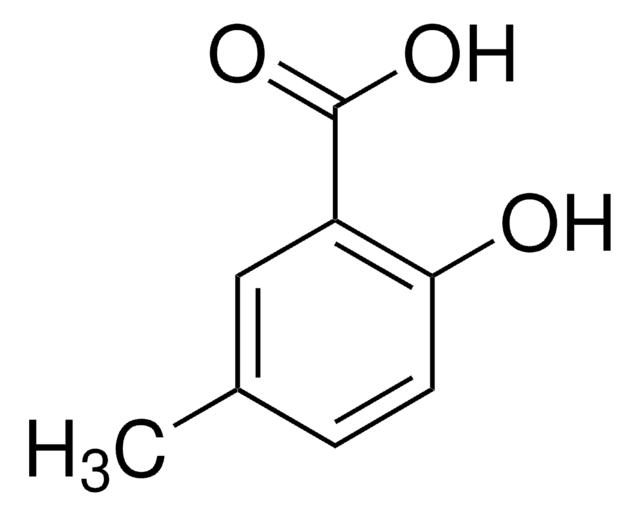146188
2-Hydroxy-5-methoxybenzoic acid
98%
Synonym(s):
5-Methoxysalicylic acid
Sign Into View Organizational & Contract Pricing
All Photos(1)
About This Item
Linear Formula:
CH3OC6H3(OH)CO2H
CAS Number:
Molecular Weight:
168.15
Beilstein:
2209647
EC Number:
MDL number:
UNSPSC Code:
12352100
PubChem Substance ID:
NACRES:
NA.22
Recommended Products
Assay
98%
form
powder
mp
141-143 °C (lit.)
functional group
carboxylic acid
SMILES string
COc1ccc(O)c(c1)C(O)=O
InChI
1S/C8H8O4/c1-12-5-2-3-7(9)6(4-5)8(10)11/h2-4,9H,1H3,(H,10,11)
InChI key
IZZIWIAOVZOBLF-UHFFFAOYSA-N
Looking for similar products? Visit Product Comparison Guide
Related Categories
General description
2-Hydroxy-5-methoxybenzoic acid is matrix additive which enhances the electrical conductivity of the matrix crystal during matrix-assisted laser desorption/ionization mass spectrometry (MALDI-MS).
Application
2-Hydroxy-5-methoxybenzoic acid was used to evaluate MALDI matrix/solvent combinations for intact spore mass spectrometry of Fusarium species.
Storage Class Code
11 - Combustible Solids
WGK
WGK 3
Flash Point(F)
Not applicable
Flash Point(C)
Not applicable
Personal Protective Equipment
dust mask type N95 (US), Eyeshields, Gloves
Choose from one of the most recent versions:
Already Own This Product?
Find documentation for the products that you have recently purchased in the Document Library.
Customers Also Viewed
T Nishihata et al.
Diabetes, 30(12), 1065-1067 (1981-12-01)
Sodium 5-methoxysalicylate, previously shown to enhance the rectal absorption of several drugs, facilitates the absorption of insulin from the upper gastrointestinal tract, resulting in significantly elevated insulin levels and lowered glucose concentrations in the plasma of rats. Restricting the movement
Osmond D Rebello et al.
Frontiers in chemistry, 8, 138-138 (2020-03-19)
Changes in the abundance of antennary fucosylated glycans in human total plasma N-glycome (TPNG) have been associated with several diseases ranging from diabetes to various forms of cancer. However, it is challenging to address this important part of the human
Kathrin Stavenhagen et al.
Molecular & cellular proteomics : MCP, 17(6), 1225-1238 (2017-12-14)
Human C1-inhibitor (C1-Inh) is a serine protease inhibitor and the major regulator of the contact activation pathway as well as the classical and lectin complement pathways. It is known to be a highly glycosylated plasma glycoprotein. However, both the structural
Stephanie Holst et al.
Scientific reports, 7(1), 16623-16623 (2017-12-02)
To characterise pancreatic cancer cells from different sources which are used as model systems to study the metastatic behaviour in pancreatic ductal adenocarcinoma (PDAC), we compared the N-glycan imprint of four PDAC cells which were previously shown to differ in
Lise Hafkenscheid et al.
Molecular & cellular proteomics : MCP, 16(2), 278-287 (2016-12-14)
Recently, we showed the unexpectedly high abundance of N-linked glycans on the Fab-domain of Anti-Citrullinated Protein Antibodies (ACPA). As N-linked glycans can mediate a variety of biological functions, we now aimed at investigating the structural composition of the Fab-glycans of
Our team of scientists has experience in all areas of research including Life Science, Material Science, Chemical Synthesis, Chromatography, Analytical and many others.
Contact Technical Service










